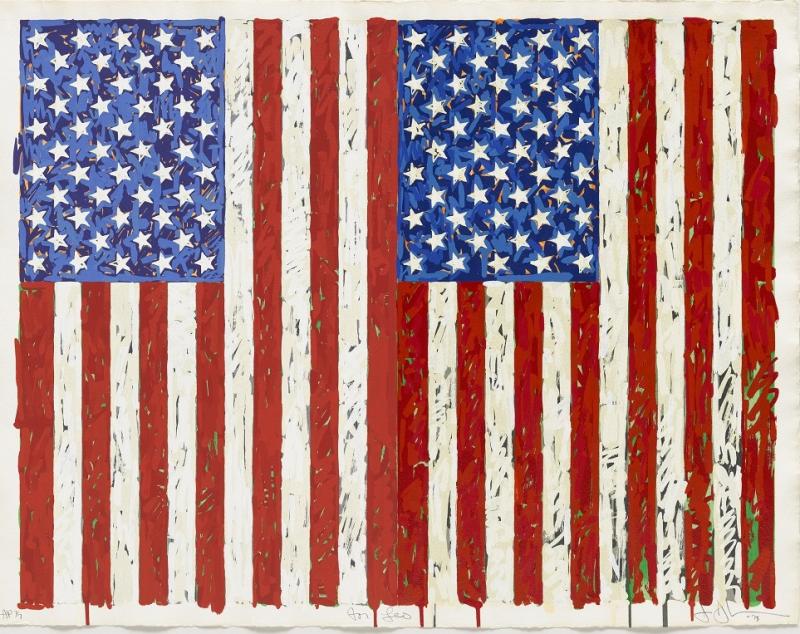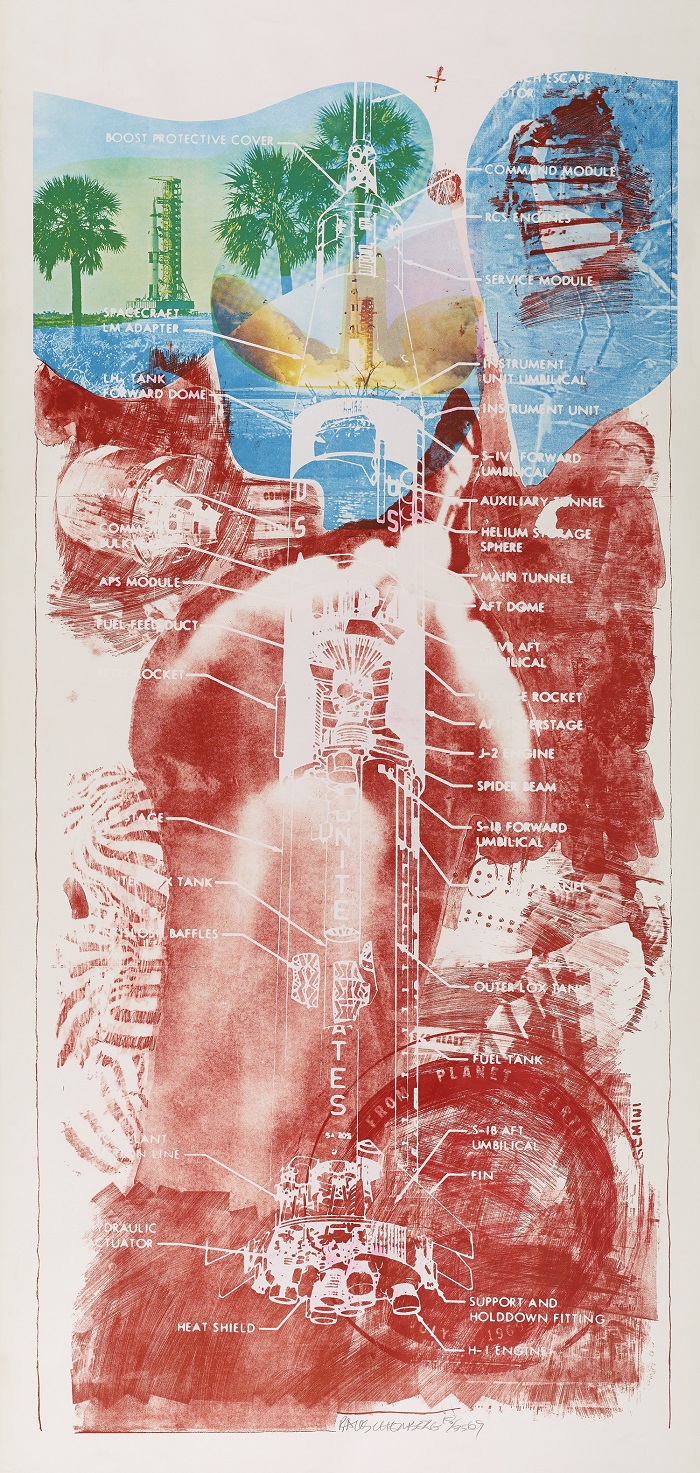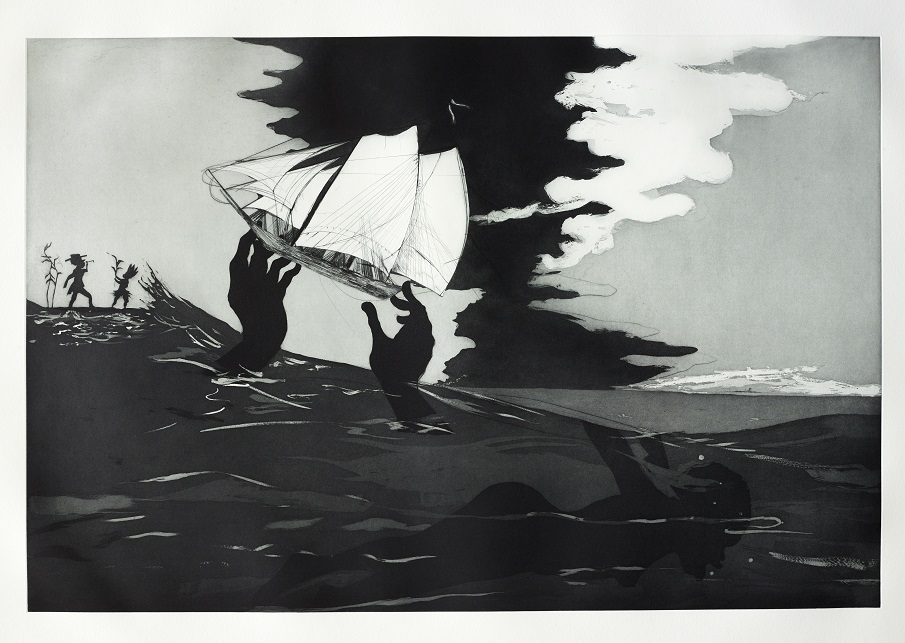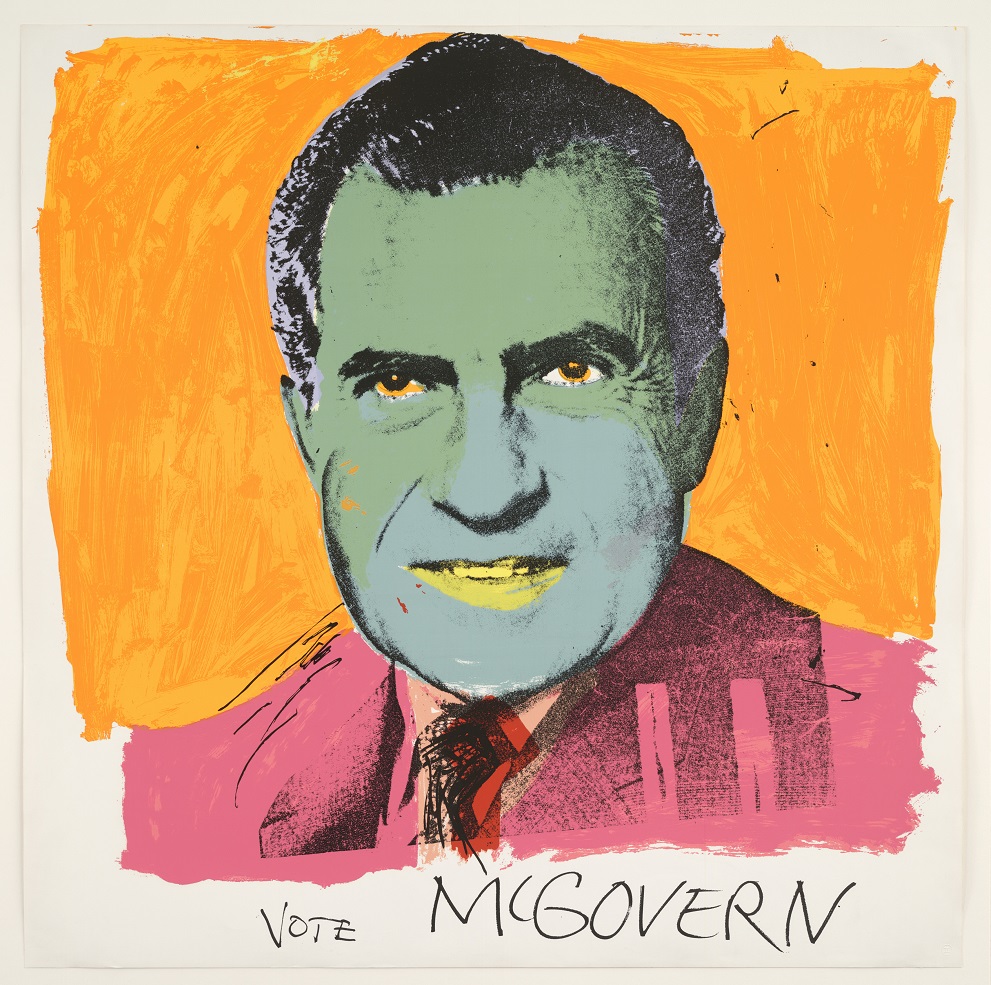The American Dream: Pop to the Present, British Museum | reviews, news & interviews
The American Dream: Pop to the Present, British Museum
The American Dream: Pop to the Present, British Museum
Sixty years of print-making makes for a thrilling all-American portrait

Dream or nightmare? Bay of Pigs, assassinations, Vietnam, space race, Cold War, civil rights, AIDS, legalised abortions, same-sex marriage, ups, downs and inside outs. From JFK to The Donald in just under 60 years, as seen in 200 prints in all kinds of techniques and sizes by several score American artists (although, shush, a handful are – shock, horror – immigrants).
In The American Dream: Pop to the Present we are rushed through the isms from pop to agitprop, Conceptualism and Minimalism to figurative Expressionism and photorealism with a bow to geometric abstraction along the way: this is a wow of an exhibition. Seven years in the thinking, four years in the planning, and judicious purchasing and gifts mean some 70 percent is owned by the British Museum, which has an increasingly significant American collection including North American Indian art – serendipitously there is a choice showing of northwest Haida art concurrently on view there.
 There are short and pithy films, interviews from Chuck Close to Julie Mehretu and Kiki Smith, and films of printmakers – cue Andy Warhol – making prints, with an elegant bow to the innovative printing firms and publishers that provided so much technical knowhow.
There are short and pithy films, interviews from Chuck Close to Julie Mehretu and Kiki Smith, and films of printmakers – cue Andy Warhol – making prints, with an elegant bow to the innovative printing firms and publishers that provided so much technical knowhow.
It is a can-do exhibition and what distinguishes it from so much of the period this side of the Atlantic is that clichéd but accurate view of American ambition, unembarrassed, unabashed, absolutely determined, thinking big. Here is something for everybody, the pains and pleasures of a diverse society expressed in images that celebrate the observed, and protest at inequalities. Prints reached a bigger audience, obviously, and various specialist and experimental print studios from Gemini GEL, Crown Point and Tamarind on the West Coast, to Andy Warhol’s screen prints emanating from his vast studio in New York, and Tatyana Grossman’s Universal Limited Art Editions to name but few.
What is so striking and accessible about this multifarious display is the way artists embraced the quotidian, responded to events, subtly campaigned. The photorealists – Richard Estes, for example – turned sharp-focus photography on its head, showing with deadpan bravura ordinary shop fronts and signage, glittering with light from the plate glass of shop windows. Robert Rauschenberg used many sources including press photographs for montage mash-ups of political figures, space rockets and the like (pictured above right: Rauschenberg's Sky Garden from Stoned Moon, 1969. © Robert Rauschenberg Foundation/DACS). Jasper Johns, of course, with his superb sense of texture and colour took as his subject the sacred American icon, the flag (main image). There is an irony in turning it into a decorative object, almost a shocking sacrilege from an artist who could make of a beer can something dignified and important. Richard Serra makes monumental black prints, while Kara Walker creates telling images of the black experience (pictured above: no world from An Unpeopled Land in Uncharted Waters, 2010. © Kara Walker). Chuck Close uses photography to make huge gridded portraits of friends and himself, imposing, impressive and curiously subversive. Ed Ruscha observes with an uncanny precision the disregarded: petrol stations, garages, rusting signs, dragging the everyday into the forefront of visual consciousness. The polemic anonymous campaigning Guerrilla girls use both text and image to indicate the disparity, through chilling statistics, of the representation of women in art. One hilarious print puts a guerrilla head on an Ingres Odalisque: Do women have to be Naked to Get into the Met. Museum?
Richard Serra makes monumental black prints, while Kara Walker creates telling images of the black experience (pictured above: no world from An Unpeopled Land in Uncharted Waters, 2010. © Kara Walker). Chuck Close uses photography to make huge gridded portraits of friends and himself, imposing, impressive and curiously subversive. Ed Ruscha observes with an uncanny precision the disregarded: petrol stations, garages, rusting signs, dragging the everyday into the forefront of visual consciousness. The polemic anonymous campaigning Guerrilla girls use both text and image to indicate the disparity, through chilling statistics, of the representation of women in art. One hilarious print puts a guerrilla head on an Ingres Odalisque: Do women have to be Naked to Get into the Met. Museum?
It seems every significant American artist of the period has tried his or her hand at print-making, but it also shows the cultural dominance of bi-coastal America.
 David Hockney is the honorary American, represented with his highly innovative Paper Pools (is the swimming pool an emblem of America?) done with Tyler Graphics: Ken Tyler, the Chicago-born son of immigrants, is a leading figure in technical innovation. More of Hockney’s quintessential Americana offers a neat supplement to Tate Britain’s retrospective. Pared-down Conceptualism/Minimalism includes Sol LeWitt, the master of the line in all its permutations. And with Warhol we have the gamut: Marilyn, Mao, Jackie, even the Campbell Soup Tin, not to mention that essential American invention of true horror, the Electric Chair. (Pictured above left: Warhol's Vote McGovern, 1972. © The Andy Warhol Foundation for the Visual Arts).
David Hockney is the honorary American, represented with his highly innovative Paper Pools (is the swimming pool an emblem of America?) done with Tyler Graphics: Ken Tyler, the Chicago-born son of immigrants, is a leading figure in technical innovation. More of Hockney’s quintessential Americana offers a neat supplement to Tate Britain’s retrospective. Pared-down Conceptualism/Minimalism includes Sol LeWitt, the master of the line in all its permutations. And with Warhol we have the gamut: Marilyn, Mao, Jackie, even the Campbell Soup Tin, not to mention that essential American invention of true horror, the Electric Chair. (Pictured above left: Warhol's Vote McGovern, 1972. © The Andy Warhol Foundation for the Visual Arts).
What is hypnotic about the anthology is its inclusiveness: touching portraits from Philip Pearlstein, stylised renderings of people from Alex Katz, Wayne Thiebaud’s delight in cafeteria food, and Vija Celmins’ superbly obsessive meditations on the ocean waves or the starry sky. A big range of Jim Dine moves from depictions of paintbrushes to bathrobes, to DIY tools and self-portraits. It is neatly divided into chapters, which means that although a big exhibition you can take your time – although more benches, please.
You can argue about who is in and who is out in this powerful, immensely enjoyable show which asks a lot of questions about whence and whither, not only for America, but also the idea of America. As the exhibition leaflet says, perhaps ironically, “Land of the free. Home of the brave”. But now what? Wherever America is heading, there will though be artists.
rating
Explore topics
Share this article
Subscribe to theartsdesk.com
Thank you for continuing to read our work on theartsdesk.com. For unlimited access to every article in its entirety, including our archive of more than 15,000 pieces, we're asking for £5 per month or £40 per year. We feel it's a very good deal, and hope you do too.
To take a subscription now simply click here.
And if you're looking for that extra gift for a friend or family member, why not treat them to a theartsdesk.com gift subscription?
more Visual arts
 Brancusi, Pompidou Centre, Paris review - a sculptor's spiritual quest for form and essence
The Paris landmark signs off with a historic survey
Brancusi, Pompidou Centre, Paris review - a sculptor's spiritual quest for form and essence
The Paris landmark signs off with a historic survey
 Expressionists: Kandinsky, Münter and the Blue Rider, Tate Modern review - a missed opportunity
Wonderful paintings, but only half the story
Expressionists: Kandinsky, Münter and the Blue Rider, Tate Modern review - a missed opportunity
Wonderful paintings, but only half the story
 Eye to Eye: Homage to Ernst Scheidegger, MASI Lugano review - era-defining artist portraits
One of Switzerland's greatest photographers celebrated with a major retrospective
Eye to Eye: Homage to Ernst Scheidegger, MASI Lugano review - era-defining artist portraits
One of Switzerland's greatest photographers celebrated with a major retrospective
 Stephen review - a breathtakingly good first feature by a multi-media artist
Melanie Manchot's debut is strikingly intelligent and compelling
Stephen review - a breathtakingly good first feature by a multi-media artist
Melanie Manchot's debut is strikingly intelligent and compelling
 Fantastic Machine review - photography's story from one camera to 45 billion
Love it or hate it, the photographic image has ensnared us all
Fantastic Machine review - photography's story from one camera to 45 billion
Love it or hate it, the photographic image has ensnared us all
 Yinka Shonibare: Suspended States, Serpentine Gallery review - pure delight
Weighty subject matter treated with the lightest of touch
Yinka Shonibare: Suspended States, Serpentine Gallery review - pure delight
Weighty subject matter treated with the lightest of touch
 Jane Harris: Ellipse, Frac Nouvelle-Aquitaine MÉCA, Bordeaux review - ovals to the fore
Persistence and conviction in the works of the late English painter
Jane Harris: Ellipse, Frac Nouvelle-Aquitaine MÉCA, Bordeaux review - ovals to the fore
Persistence and conviction in the works of the late English painter
 Sargent and Fashion, Tate Britain review - portraiture as a performance
London’s elite posing dressed up to the nines
Sargent and Fashion, Tate Britain review - portraiture as a performance
London’s elite posing dressed up to the nines
 Zineb Sedira: Dreams Have No Titles, Whitechapel Gallery review - a disorientating mix of fact and fiction
An exhibition that begs the question 'What and where is home?'
Zineb Sedira: Dreams Have No Titles, Whitechapel Gallery review - a disorientating mix of fact and fiction
An exhibition that begs the question 'What and where is home?'
 Yoko Ono: Music of the Mind, Tate Modern review - a fitting celebration of the early years
Acknowledgement as a major avant garde artist comes at 90
Yoko Ono: Music of the Mind, Tate Modern review - a fitting celebration of the early years
Acknowledgement as a major avant garde artist comes at 90
 Unravel: The Power and Politics of Textiles in Art, Barbican review - the fabric of dissent
An ambitious exploration of a neglected medium
Unravel: The Power and Politics of Textiles in Art, Barbican review - the fabric of dissent
An ambitious exploration of a neglected medium
 When Forms Come Alive, Hayward Gallery review - how to reduce good art to family fun
Seriously good sculptures presented as little more than playthings or jokes
When Forms Come Alive, Hayward Gallery review - how to reduce good art to family fun
Seriously good sculptures presented as little more than playthings or jokes

Add comment